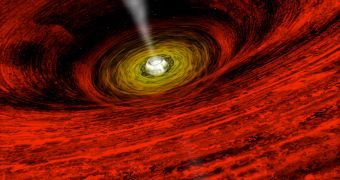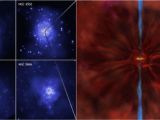It is a well known fact that black holes can spin with extreme speeds, yet new observations conducted with NASA's Chandra X-ray Space Telescope reveal that supermassive black holes could even reach rotation speeds close to the upper limits allowed in the space-time fabric. Not only that, but physicists also proposed that a massive object such as a supermassive black hole could in fact spin the whole space in their near vicinity, giving rise to strange temporal effects.
The actual spin speed of a black hole can only be detected during the 'feeding' process, as its massive gravitational pull accumulates matter and concentrates it into a hot accretion disk of matter, radiating high energy X-ray light. Without an accretion disk, nothing can differentiate a black hole from another, except for its mass. Spinning material being drawn towards the event horizon cannot be entirely swallowed by the black hole, thus it is ejected from the system through the poles of the object, in the form of large particle jets, some stretching millions of light years into intergalactic space.
As they travel through space, these particle jets may occasionally collide with other galaxies, affecting their star formation process. Out of a sample of about nine black holes situated in gigantic galaxies, Chandra discovered massive distortions in their interstellar gas, suggesting that the black holes at their centers would spin at nearly the maximum rates allowed by the Theory of Relativity.
The study presented by Rodrigo Nemmen, a graduate student at Penn State University, is further backed up by previous observations conducted on these massive objects. The fast rotation of the material in the accretion disk corroborated with the spinning effect of space predicted by Einstein's theory could determine the appearance of a strong magnetic field, that powers the high-speed particle jets emitted by the black hole.
Furthermore, the impressive spin rates of the black holes may be imposed by galactic merging process, which then propagates towards the accretion disk orbiting the object. Considering the fact that galactic mergers are quite common in the universe and were much more frequent in the past, such relativistic spinning rate could be a property of supermassive black holes.
The huge particle jets hitting other galaxies could in fact affect the star formation capabilities of the respective galaxy by heating up the intergalactic clouds of gas and dust within it, thus preventing them from collapsing to form larger objects, which, in turn, limits the size of the central core.

 14 DAY TRIAL //
14 DAY TRIAL // 
